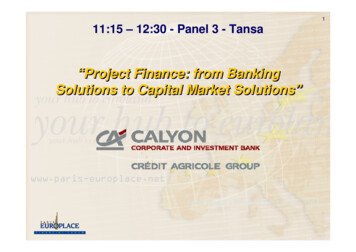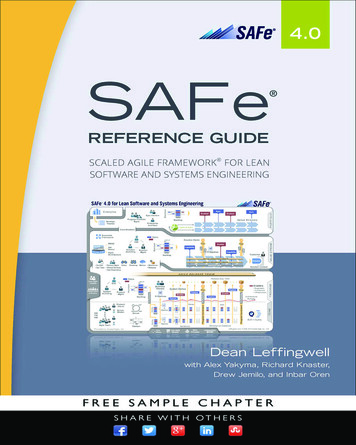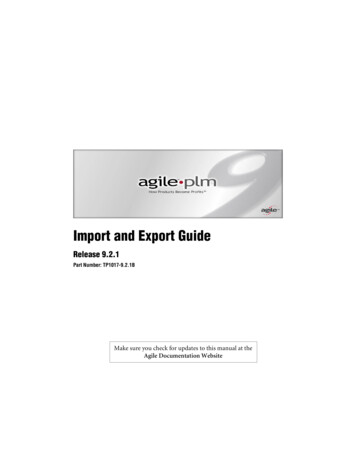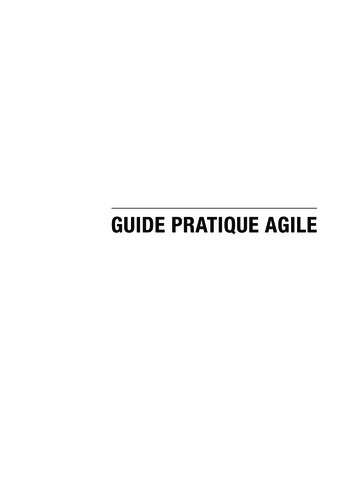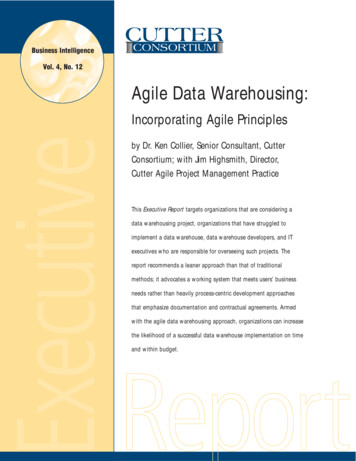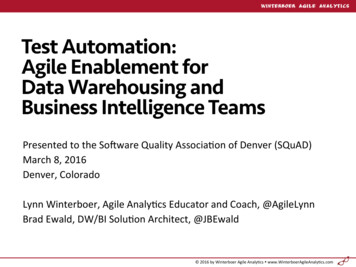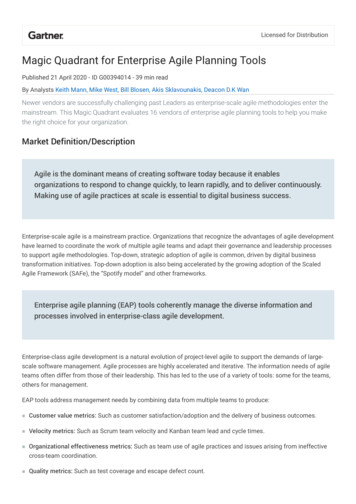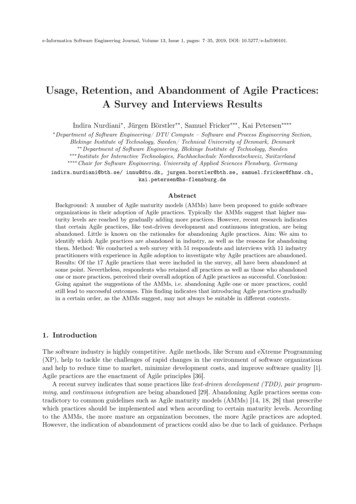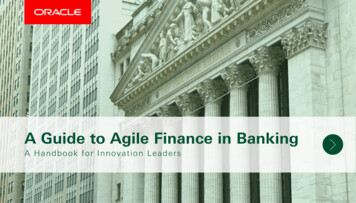
Transcription
A Guide to Agile Finance in BankingA Ha n d book for Innovati on L e ad e r s
ContentsIntroductionWhen banking CFOs get a chance to meet for lunch, there’s morethan daily specials on the menu.The Case for Change in the Office of the CFO:Toward Agile FinanceRegardless of your specific needs, there are some commoncharacteristics that should be considered for any ERP modernization.Oracle and Modern ERP in BankingThe banking industry is unique and under extreme pressure forchange, so how do you measure success?Oracle’s enterprise-grade cloud is a complete system that letsyou connect to other clouds and on-premises systems for trueintegration. It’s a modular solution so you can modernize your ERPon your timeline.Technology for Agile FinancePlanning and Deploying Modern ERPAs a decision maker in the banking industry, you’re probablyalready taking a hard look at your on-premises ERP system—and ifyou aren’t, you should be.The steps for planning a modern ERP strategy for banking includesa comprehensive statement of intended outcome, but must alsoconsider the process.Is the Time Right for You to Modernize?Get Started with Your AgileFinance ModernizationHas your organization reached a key inflection point—that pointwhere you’re facing substantial upgrades to your on-premisesERP software and hardware just so you can support evolvingoperational goals?ContentsWhat to Look For:“Must Haves” for the Modern ERP SystemAccomplish your modernization goals with Oracle ERP cloud:Manage costs, achieve operational efficiency and service excellence,and focus on the innovation that distinguishes your institution.A Guide to Agile Finance in Banking2
IntroductionWhen chief financial officers (CFOs) from leading banking institutionsfinally take the time to do lunch, daily specials aren’t the only thing onthe menu.The conversation starts with trading snapshots of latest financialresults, but soon turns to an earnest discussion of sharedchallenges—crazy-like-a-fox competition, persistent change, andburgeoning compliance requirements.But one hungry CFO is among those who are already making the leapto agile finance with cloud-based ERP solutions.“We’re already seeing the benefits from integrating data, processes,and analytics to support all aspects of our finance ecosystem—including compliance,” she confirms. “We’ve reduced the costs ofmaintaining shared services, we have more transparency and morecontrol, and we’re responding faster to regulatory changes. We’vealso been able to move resources from transactional tasks to morestrategic positions.”“One thing is absolutely clear everybank is going to need to transformitself. The digital revolution is changingbanking on just about every dimensionthat you can imagine.”Richard Fairbank, CEO, Capital OneFrom “Capital One: Think More Like a Tech Company, Less Like aBank,” Bank Innovation.Read the ArticleTaking a sip of sparkling water, she smiles and adds, “Lunch is on me.”IntroductionA Guide to Agile Finance in Banking3
The Case for Change in theOffice of the CFO: TowardAgile FinanceThe challenges are clear: Your bank is under extreme pressures, includingtightening margins and increased competition—not to mention a plethoraof regulations and a fast-moving market for new offerings and delivery channels.The Benefits of Agile FinanceGreater EfficiencyBetter InformationMore InfluenceEmerging technologies will significantly transform businesses over the nextfive years—especially in the office of the CFO—and savvy boards and CEOsare looking at a new way to operate in this ever-changing environment.It’s called Agile Finance. It’s resilient, responsive, and predictive, andcorporate leaders understand that it’s a game changer.What Drives Agile Finance?Analyzing opportunities to mitigate risks.Accelerating an organization’s ability to bring new productsto market.Delivering forward-looking analysis that identifies newgrowth opportunities.Taking a leadership role in measuring and understanding the intangibledrivers of value.Chapter 1: The Case for Change in the Office of the CFO: Toward Agile FinanceA Guide to Agile Finance in Banking4
Leading the Way to Agile FinanceAgile Finance leaders work differently from their moretraditional counterparts.In a recent study of 483 senior finance executives,researchers found businesses using Agile Finance were“It’s all about increasing control, reducingcosts, and improving transparency aroundthe cost base so businesses understandtheir drivers and can make bettercommercial decisions.”more likely to have fully implemented cloud ERP forstandardizing their accounting processes and more likelyto demonstrate agility and achieve profitable growth.“Agile Finance: The New Operating Model forModern Finance” from AICPA and Oracle, 2017.Joanna Felding, CFO, HSBCThe New Operating Model for Modern FinanceRead more about Agile Finance in this new report from AICPAand Oracle.Download the ReportHSBC Discusses Their Global Finance TransformationWatch the VideoChapter 1: The Case for Change in the Office of the CFO: Toward Agile FinanceA Guide to Agile Finance in Banking5
Technology forAgile FinanceTraditional, on-premises ERP systems focus on integrating core businessprocesses and require substantial customization—particularly true forbanking institutions, whose needs can be significantly different fromother industries.As a decision maker in the banking industry, you’re probably already taking ahard look at your on-premises ERP system—and if you aren’t, you should be.These systems don’t offer “anytime, anywhere, any device” access,and—given the capital expense associated with updating on-premisessystems and the specialized, internal staff needed to maintain them—legacy,on-premises ERP has proven to be a costly model.The challenges and industry pressures in your organization are exacerbatedby the disproportionately high costs of internal operations associated withfinancial, management, external, and regulatory reporting—reporting that’soften linked to outdated legacy technology systems.Contending with worsening efficiency ratios, fintechcompetition, and ever-increasing regulatory burdens,90% of banks have unsustainable efficiency ratios.From Brookline Branch, in Industry Trends, 201690% of banks have unsustainable efficiency ratiosRead the ArticleChapter 2: Technology for Agile FinanceA Guide to Agile Finance in Banking6
A New Definition of Success: What Changed?Whether you’re talking about the boardroom or the back office, the factors drivingyou to modernize your ERP are essentially the same:Manage costs—Leverage standardization and automation in processes and intechnology to maintain expenses or save money.Refocus resources—Simplify operations, drive productivity, and spend moretime on your organization’s core mission.Fuel innovation—Deliver the tools and the insight to differentiate and innovate.Enabling Greater Business AgilityDive deeperChapter 2: Technology for Agile FinanceA Guide to Agile Finance in Banking7
CloseEnabling Greater Business Agility:A Model for Modern FinanceAccording to a recent study by AICPA and Oracle, businessessupported by Agile Finance leaders are more likely to demonstrateagility and achieve profitable growth.When modern finance teams embrace an Agile Finance operatingPositive Revenue Growth63%89%VSAgile Finance ModelTraditional Finance Modelmodel, they create organizations that can respond quickly tochange. The new model uses digital technologies proactively toautomate transactional work that is too often done by hand. ItIncreasing Profitabilityalso invests in new skill sets that can provide management withanalytical insights and strategic guidance.70%Traditional Finance ModelFrom “Agile Finance: The New Operating Model for Modern Finance” from AICPA and Oracle, 2017.VS95%Agile Finance Model
From On-Premises to Cloud—Making theMove to Modern ERPCloud ERP solutions meet the digital requirements that today’s usersexpect. They offer sophisticated data access and analysis along withbuilt-in collaboration and social features. By turning to modern,cloud-based solutions, banking institutions are seeing benefitsthat include:A subscription business model that transforms capital expenses intooperating expenses.Automatic upgrades and continual maintenance.Easy integration with on-premises systems as well as with mobileplatforms and related applications.Cloud-based ERP also eliminates the need for budget-killing, multiyear ITprojects and heavy customization—letting you move your IT resources tofocus on the mission of your institution.Chapter 2: Technology for Agile FinanceLloyds Bank Modernizes Finance with Oracle ERP CloudWatch the VideoA Guide to Agile Finance in Banking8
Is the Time Right for Youto Modernize?Has your organization reached a key inflection point—that turning pointwhere you’re facing substantial upgrades to your on-premises ERPsoftware and hardware just so you can effectively support changingoperational goals and the basic needs of your organization? If so, thenmaybe it’s time to modernize.In a recent study by AICPA and Oracle, more than 80%of respondents reported that their finance function hasa leading role to play in driving business agility. But only30% agreed or strongly agreed that their finance functionis actually providing the forms of support that businessesneed to become agile.“Agile Finance: The New Operating Model forModern Finance” from AICPA and Oracle, 2017.Chapter 3: Is the Time Right for You to Modernize?Chances are that your existing system has been customized to the pointwhere upgrades and additions will require significant resources andsignificant time—sometimes 18-24 months. This is the point where manyorganizations turn to cloud-based ERP because it can provide fasterdelivery of the modernized systems you need to achieve your goals.Clearly, there are benefits to ERP cloud, but when is the right time tomake the move, and what steps do you need to take? Just as important,how do you find the right vendor/partner and solution for your institution?Comparing Financial Models Cap-Ex vs Op-ExFor many institutions, it’s the capital versus operating expense math thatmakes the decision easier.Instead of investing capital in on-premises ERP systems that will continueto need significant resource investments for software and hardwareupgrades, maintenance, and database expenses, you can eliminate mostof these costs using the cloud subscription model.The bottom line?Your organization can reallocate funds that were previously designatedfor the back office and use them for growth, innovation, and the moremission-specific goals of your institution.A Guide to Agile Finance in Banking9
Top 10 Signs It’s Time to Deploy Modern ERPDo you see any of these signs in your institution? Select all that applyand then check what your score means at the bottom.123456Increased ERP maintenance costs. Increased customizations,integrations, and consulting services to your on-premises ERP systemare adding to overall IT costs.Required upgrades to legacy ERP. Your on-premises system is pastdue for expensive upgrades for both software and hardware.Shadow systems and disparate data. Other groups are establishingtheir own systems. Multiple sources of truth mean conflicting answersto critical operational questions.78910New sources of revenue. Your institution is considering alternativerevenue streams and business models, but doesn’t have the systemcapabilities to model scenarios and make timely decisions.Data analysis paralysis. You’re pushing the limits of your ERP dataanalysis capabilities and, as a result, hindering the work of yourmanagers and analysts.Increased reporting challenges. Your legacy ERP system can’tsupport the increasing reporting requirements or provide the insightnecessary to make informed decisions.New compliance requirements. Increased requirements for financialand regulatory compliance are testing the limits of your ERP system.Adopting best practices. Your institution is realizing that adoptingcross-industry best practices can help it thrive.How many signs do you seein your institution?Dissatisfied users. Your employees are complaining about usabilityand complex processes because they expect the same ease of use andresponsiveness they get from their social apps.0-3Start investigating options for moving to a modern,cloud-based ERP system.4-6You should be crafting a modernization plan and lookingat vendors.Expansion plans. Your institution is expanding—for example,through mergers and acquisitions or by partnering with other groupsand institutions.Chapter 3: Is the Time Right for You to Modernize?7 You’re probably already on your way to moving to a modern,cloud-based ERP system.A Guide to Agile Finance in Banking 10
What to Look for:“Must Haves” for theModern ERP SystemIntegrationRegardless of your specific needs, there are some commoncharacteristics that should be considered for any ERP modernization. Inaddition to a comprehensive statement of intended outcome, the stepsfor planning a modern ERP strategy must consider a thoughtful processof transformation.AnalyticsModern PlatformConfigurabilityUse a standards-based platform for “upgrade safe”enhancements that replace customization requirementswith “in-app” personalization and configuration. Extendapps using the cloud platform.SecurityDedicated financial services cloud environment offerssecure data isolation, segregation of duties, end-to-endencryption, a Bastion security model, and data residencyaligned with FINRA.One standards-based integration platform for finance,management reporting, and servicing systems lets youconnect with other clouds, on-premises systems, andthird-party systems and have all your connections in onesecure place.Embedded analytics for real-time, multi-dimensionalanalysis. Unified financial and planning data as well asadvanced analytics and visualizations for big data.Modern Set of Complete CloudFinancial ApplicationsComplete functionality: average daily balance, revaluation,Multi-GAAP.Complete suite of more than 590 SaaS applications with social andmobile capabilities.Complete cloud (DaaS, SaaS, PaaS, IaaS).Increased productivity with lower cost, standards-based applications.Superior user experience: A modern user experience with mobileaccess and social integration that supports collaboration.Chapter 4: What to Look For: “Must Haves” for the Modern ERP SystemA Guide to Agile Finance in Banking 11
“We are no longer interested in customizations. We arelooking for a one way of doing things. We want to beupgraded every six months so that we never have to waitfive years to get a functional upgrade. We wanted apublic cloud solution.”Matthew Trager,Head of Finance Data and Architecture, Lloyds Banking GroupChapter 4: What to Look For: “Must Haves” for the Modern ERP SystemA Guide to Agile Finance in Banking 12
Oracle and Modern ERPin BankingOracle’s financial cloud is a complete system that lets you connect to otherclouds and to on-premises systems for true integration. It’s a modularsolution, so you can modernize your ERP on your timeline, in the solutionorder that aligns with the goals of your organization.With Oracle ERP cloud, built-in functionality meets the unique needs ofbanking, including tools that improve time to financial close andmore-refined cost analytics and financial sub-ledger reporting.Oracle Financials CloudSocial collaboration with a variety of accounting functions, including theability to enter expenses via mobile devices.Oracle Procurement CloudPervasive analytics and real-time transactional data to monitor spending andenable more-informed decisions.Procurement optimization across the institution that saves money with bettersourcing, compliance, and supplier awards. Provides collaboration on buyingdecisions through a secure social network.Oracle Project Management CloudAccelerated delivery of projects across the institution with project, resource,and task management.Collaboration among administrative and academic departments to plan,schedule, staff, and monitor projects and resources with modern, social,mobile, and analytic tools.Oracle Project Financial Management CloudVisibility and access to all ledgers for users closing the books.Highly automated and streamlined project-costing process to capture andaccount for project costs and commitments.Collaboration for real-time status and progress.Complete award process management—from funding to close out.Complete audit trails with collaboration tied to associated transactions.Financial management of awards with sponsor compliance as well as internalcontrol, billing, and reporting requirements.Oracle Financial Accounting HubQuickly create accounting sub-ledgers for disparate and disconnectedtransactional and general ledger systems.Apply accounting policy consistently; eliminate errors with touchless processing.Centralize and secure the accounting process while enhancing audit andreconciliation.Get complete insight with real-time, multidimensional reporting.Chapter 5: Oracle and Modern ERP in BankingA Guide to Agile Finance in Banking 13
Planning and DeployingModern ERPPlanning a modern ERP strategy includes considering the internal andexternal players, the process, as well as your intended outcome.Step 1: Secure and communicate executive buy-in and sponsorshipSee “Your Complete Guideto Modern ERP”Step 2: Involve users and process owners from the startRead the eBookStep 3: Define measurable goals so you can assess milestone progressStep 4: Map future business processesStep 5: Map your current IT infrastructureStep 6: Choose a deployment approach: incremental, comprehensive, or hybridStep 7: Address reporting and analytics earlyBetter, Faster Information with Oracle ERP CloudWatch the VideoChapter 6: Planning and Deploying Modern ERPA Guide to Agile Finance in Banking 14
Get Startedwith Your AgileFinance ModernizationAccomplish your modernization goals with Oracle ERP cloud: Managecosts, achieve operational efficiency and service excellence, and focus onthe innovation that distinguishes your institution.With more than 40 financial services cloud customers in more than 10countries around the world, Oracle’s global sales team and partners areready to get you started on your journey to ERP modernization.Lloyds Bank Chooses Oracle ERP Cloud to Transform FinanceWatch the Video“It’s the first time I’ve ever been part of a projectwhere we didn’t have to spend nine months doingrequirements. It was a transformative operating modelStart Your Journey to Oracle ERP Cloudthat would change how business and IT work togetherVisit cloud.oracle.com/erp-cloud to learn more about Oracle ERPCloud solutionsand allow us to focus on what we’re good at.”Learn more about all of Oracle’s solutions for banking institutionsMatthew Trager, Head of Finance Data andArchitecture, Lloyds Banking GroupRegister for an Oracle ERP Cloud demoChapter 7: Get Started with Your Agile Finance ModernizationTalk to a sales representative at 1-800-633-0738A Guide to Agile Finance in Banking 15
Copyright 2017, Oracle and/or its affiliates. All rights reserved. Oracle andJava are registered trademarks of Oracle and/or its affiliates. Other namesmay be trademarks of their respective owners.
Oracle and Modern ERP in Banking Oracle’s enterprise-grade cloud is a complete system that lets you connect to other clouds and on-premises systems for true integration. It’s a modular solution so you can modernize your ERP on your timeline. Planning and Deploying Modern ERP The steps for planning a modern ER

